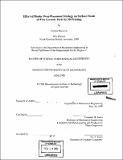Effect of binder drop placement strategy on surface finish of fine ceramic parts by 3D printing
Author(s)
Knezevic, Vedran, 1974-
DownloadFull printable version (46.67Mb)
Other Contributors
Massachusetts Institute of Technology. Dept. of Mechanical Engineering.
Advisor
Emanuel M. Sachs.
Terms of use
Metadata
Show full item recordAbstract
The interaction of droplets with powder is the key set of phenomena that determine many aspects of Three Dimensional Printing (3DP) including dimensional control and surface finish of the printed part. In the creation of structural ceramic parts by 3D printing, fine powders on the order of 1 gm in size must be used. These powders are deposited as slurry and then dried to form a fairly hard cohesive powder bed. The purpose of this work is to understand the interaction of droplets with such cohesive powder beds, the integration of droplets with previously printed droplets, and to explore print styles which improve the dimensional control and surface finish. Single drop primitives were printed and removed from the powder bed and found to resemble discs with a flat top and a rounded bottom with a typical diameter of 180 Vtm and a thickness of 40 [tm. A number of different time domains are defined based on the interaction of droplets with cohesive powder beds. Critical times in defining these domains are: 1) the amount of time it takes for a droplet to splat and spread on the powder bed, 2) the amount of time it takes for the droplet to absorb into a powder bed, and 3) the amount of time it takes for an absorbed droplet to dry. Based on these time domains, doublets composed of two printhead droplets spaced 40 and 80 pm apart were printed at different interarrival times. At short interarrival times, the doublet appeared to be roughly equivalent to a single drop primitive but slightly larger. As the interarrival time increased the doublet became increasingly oblong. When printing continuous line segments high rate printing requires that droplets be placed as rapidly as possible. Line segments with varying drop deposition styles were investigated. In one style, droplets are deposited one after the other at high rate such that droplets are arriving before the previous droplets are absorbed into the powder bed. Such line segments show evidence of binder rearrangement due to capillary effects on the surface of the powder bed. Two fundamental alternative styles were investigated where droplets are printed far enough apart that they interact with the powder bed and not with liquid on the surface of the powder bed. In the most successful of these styles, a line segment is created in either 2 or 4 passes of the printhead and droplets are always deposited in a symmetrical configuration with respect to previously deposited droplets. For example, in a first pass, droplets are deposited 200 microns apart and in a second pass droplets are once again deposited 200 microns apart but at a position intermediate to the droplets deposited on the previous pass. Such line segments showed straighter edges and narrower widths than those printed with single pass high frequency printing.
Description
Thesis (S.M.)--Massachusetts Institute of Technology, Dept. of Mechanical Engineering, 1998. Includes bibliographical references (leaf 106).
Date issued
1998Department
Massachusetts Institute of Technology. Department of Mechanical EngineeringPublisher
Massachusetts Institute of Technology
Keywords
Mechanical Engineering.